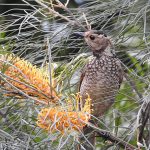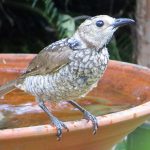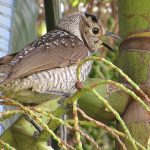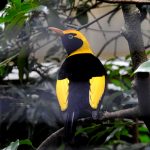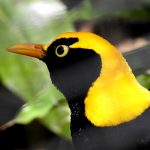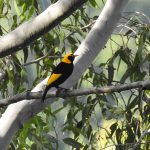REGENT BOWERBIRD
The Regent bowerbird is a striking and colorful bird species native to eastern Australia. It belongs to the family Ptilonorhynchidae, commonly known as bowerbirds, which are known for their unique courtship behavior involving the construction of elaborate bowers to attract mates.
The Regent bowerbird exhibits pronounced sexual dimorphism, with males and females having distinctly different appearances.
The male is one of the most visually stunning birds in Australia. They have a predominantly black plumage with bright golden-yellow highlights on their head (hence the name “chrysocephalus,” meaning golden-headed). Their wings and tail may also have hints of metallic blue or green when caught in the right light. During the breeding season, adult males display vibrant colors to attract females.
In contrast, female regent bowerbirds have a more subdued appearance. They are mostly olive-green with lighter underparts, which provides them with good camouflage while nesting and incubating eggs.
The male Regent bowerbird constructs an elaborate and intricate bower on the forest floor. Unlike some other bowerbird species, the regent bowerbird’s bower is not a tower-like structure but more of an avenue or corridor made from sticks and twigs, with a cleared “display court” area at the end. The male decorates the bower with various brightly colored objects, such as flowers, berries, feathers, and even man-made items like bottle caps or pieces of plastic.
The purpose of the bower and the carefully arranged decorations is to impress female bowerbirds during courtship displays. The male will perform elaborate dances, vocalizations, and postures in front of the bower to attract the attention of passing females. If a female is impressed, she may choose to mate with the male and may also inspect his bower.
Regent bowerbirds are found in the eastern coastal regions of Australia, including Queensland and parts of New South Wales. They inhabit a range of forested habitats, including rainforests, eucalypt woodlands, and coastal scrubs.

